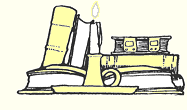
Good Friday, 9 April 2009
This is a little essay on how I understand salvation. It's not the only way to understand it, I know, and it isn't even a new way – or it's not supposed to be! – but it's not the one you hear most often.
I think it is much more important to believe in salvation than to understand it, but understanding it can help you hold onto or strengthen your belief. I don't think we can completely understand it, but analogies and models can help. The commonest model, I think, is the "judicial" model, in which salvation is Christ paying a fine we owe and could never pay ourselves. That's a good analogy, but there are others, and this is one that helps me over some difficulties that the judicial model doesn't. Call it the Second Adam model.
Paul calls Christ the Second Adam, and says that a Christian is a new being in Christ. Through Christ, God is creating a new version of human nature, a second humanity. Because of the Incarnation, the human race has two possible natures we can choose between. The canonical way of choosing the new humanity is by belief and baptism.
This model "explains" why Christ was born of a virgin, to some degree. If he had not been born of humanity at all – if God had simply created a body for him from the dust of the ground, for instance – he wouldn't really be human at all, even if the physical resemblance was exact; there would be no connection of fact and history. If he had simply been born of two human parents, you'd just get another standard Humanity V1.0 human, unless God suspended or undid the normal process of procreation – but I don't think "undoing" is God's "style" – see below.
So Christ is born of Mary in order to be genuinely human, but he is born in a new and miraculous way in order to be a member – the founding member, the first fruits – of the new humanity.
The new humanity builds on the old one. God is a creator, and, as a creator, He doesn't simply undo, uncreate, very often. Not only does He not undo what He has done Himself, He does not undo what we have done. For we are made in His image, and what we do is supposed to count for something.
So, He makes humanity free of death. Then we sin, fall, and become mortal. By joining the new humanity, we don't simply cancel out or evade sin and death – we become the kind of human that sins but repents and reforms, and the kind that still dies but rises again.
Return to Introduction to Essays
Return to Wind Off the Hilltop
Copyright © Earl Wajenberg, 2011